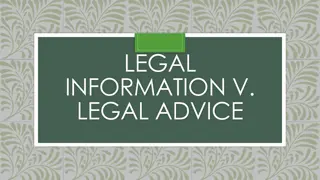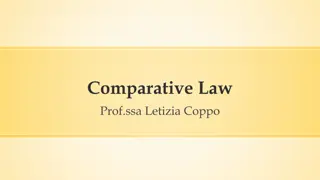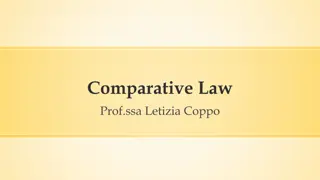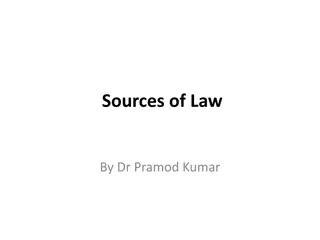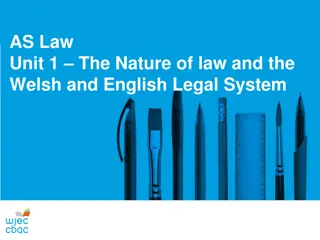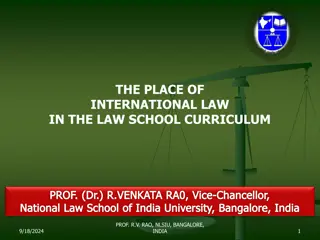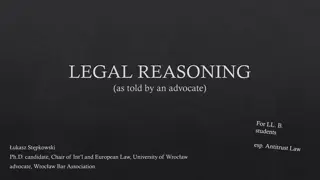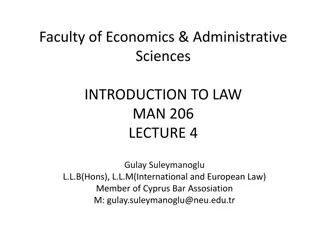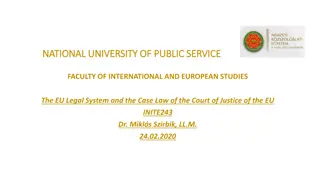Understanding Legal Systems and Sources of Law
Legal systems are created through factors like rules forbidding or compelling conduct, compensation for injuries, court systems, and a rule-making body. Sources of law include statutes, customs, judicial decisions, legal principles, and jurists' opinions. There are different national legal systems with variable structures and characteristics, organized based on written constitutions or unwritten frameworks. Major legal traditions include civil law and common law systems, each with unique characteristics in law-making, legal principles, and judicial roles.
Download Presentation

Please find below an Image/Link to download the presentation.
The content on the website is provided AS IS for your information and personal use only. It may not be sold, licensed, or shared on other websites without obtaining consent from the author. Download presentation by click this link. If you encounter any issues during the download, it is possible that the publisher has removed the file from their server.
E N D
Presentation Transcript
Five factors that create a legal system (Hart) Rules that forbid certain conduct and rules that compel certain conduct on pain of sanctions; Rules requiring people to compensate those whom they injure; Rules stating what needs to be done in certain mechanical areas of law, such as making a will or a contract; A system of courts to determine what the rules are, whether they have been broken and what the appropriate sanction is; A body whose responsibility is to make rules and amend or repeal them when necessary.
Basic elements for distinguishing legal systems sources of law legal principles and concepts historical background
What makes a legal system? sources of law and their hierarchy 1. 2. law-making institutions (and their hierarchy) 3. law-enforcing institutions and their powers (mostly courts) 4. substantive and procedural principles and concepts 5. the organisation of the legal profession (the judiciary, the lawyers)
National legal systems Each state has its own legal system. The structure and characteristics of these systems are highly variable. Some legal systems are organized on the basis of a written constitution (e.g. the United States), some have constitutional systems not resulting from a single written text unwritten constitution (e.g. the United Kingdom), and some do not have an explicit constitutional framework.
Sources of the law Statutes Customs Judicial decisions Legal principles The opinions of jurists
Two major legal traditions Civil law (continental law) system Common law system
Civil law v. Common law CIVIL LAW COMMON LAW MAIN SOURCE OF LAW legislation (codified law) case law (precedents) LAW-MAKING BODIES legislative bodies the judiciary CREATION OF LEGAL PRINCIPLES from general and abstract; deductive reasoning: applying a general principle to a particular case from specific and individual; inductive reasoning: legal principles derived from individual cases ROLE OF THE JUDICIARY interprets and applies the law creates the law (precedents) TYPE OF LEGAL PROCEDURE inquisitorial adversarial
Inquisitorial legal procedure the role of the judge: to establish facts asks questions in order to get to the truth the role of the legal representatives: to ask additional questions to point to what they think might be relevant details in the case
Adversarial procedure the role of the parties: to provide evidence and convince the judge and/or jury of their version of the truth the role of the jury: to establish facts based on the presented evidence the role of the judge: to make sure procedure is followed and to make a ruling applying the law to the facts established by the jury or him/herself
Civil law system Countries that have inherited the Romano-Germanic traditions. Within the civil law tradition, the French legal tradition and the German legal tradition can be distinguished. They are based on Roman law and they share a tradition of devising systematic, authoritative and comprehensive codifications as their law-making style, working from general concepts and providing solutions to individual problems
Common law systems Mostcommon law systems do not have codes. Great importance is given to the decisions of judges to be followed in later, similar cases (precedents). The decisions of higher courts are binding on lower courts, and much of the law is left to the courts to develop.
New trends The division of national legal systems into families or cultural groupings is weakened by the increasing contemporary influence of international agreements and legal sources. For instance, the national laws of member states of the European Union are increasingly shaped by the need to comply with the requirements set out by EU law. In other cases, international agreements with a potentially universal scope determine to a large extent the contents of national law.
Answer the following questions: What constitutes a legal system? What is a source of law? What are the major sources of law? How would you define case law? How can we define a precedent? Which type of legal reasoning is deductive: civil law or common law? Which type of legal reasoning is inductive: civil law or common law? Why have civil law and common law systems come closer together recently? What is the impact of international law on national legal systems?
Match two parts of the following sentences: 1.Case law is a. an established written law, especially an Act of Parliament 2.Code is b. ... law established by precedents 3.Consolidation is c. decisions of courts in earlier similar cases 4.Enactment is d. an official set of laws or regulations 5.Precedents are e. the action of making a law 6.Statute is f. the act of bringing together various Acts of Parliament which deal with one subject into a single Act
Fill in the missing words: academic legal authority opinions judgment judicial precedents reports Judgments in common law vs. civil law The nature of ________________in French law could not be further from its English counterpart. Whereas some of the leading English _____________ decisions contain the reasoned ________________of judges, distinguishing and applying a long list of _____________ and stretching through over 100 pages in the law ______________ French judgments, even emanating from the Courde Cassation, rarely amount to two pages. They are in the form of a syllogism: they set out the facts, the _____________issue and the conclusion, usually without citing any previous case _________________. Because judgments are so short, they are normally published accompanied by _____________commentary.




